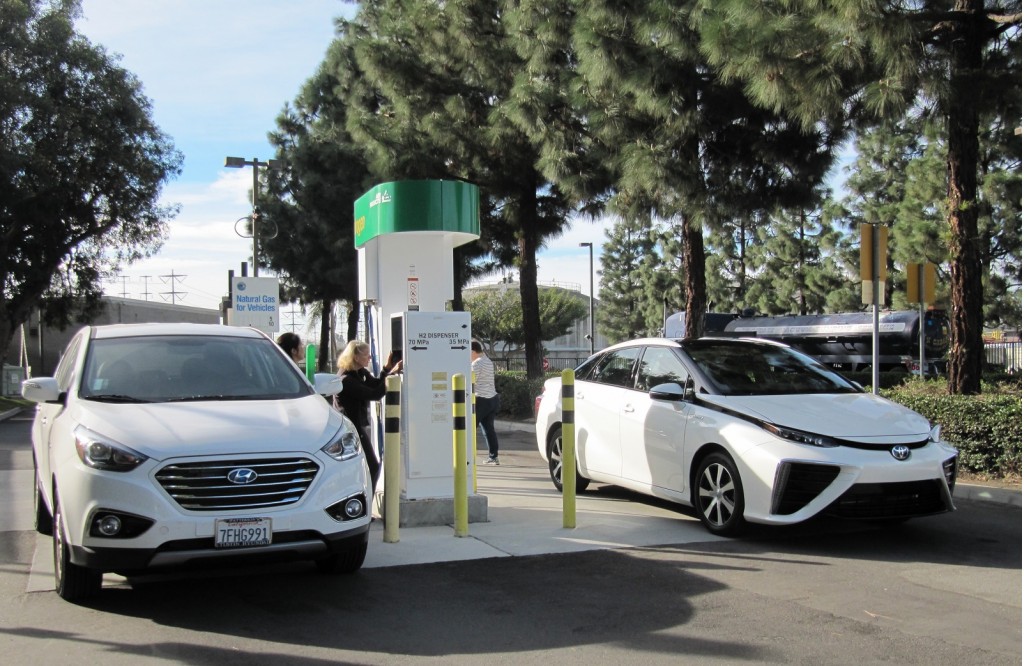Hydrogen fuel-cell vehicles are rolling out to California buyers in small numbers with two models on the market, and hydrogen stations slowly expanding outside a narrow slice of Los Angeles.
The Honda Clarity Fuel Cell vehicle first went on sale in California at the end of 2016, and 2018 models just arrived.
The Toyota Mirai has also been available in California since 2016, giving California buyers a choice of zero-emissions fuel-cell cars. Hyundai, too, offered a fuel-cell version of its previous Tucson SUV until recently, albeit only for lease.
DON'T MISS: 2017 Honda Clarity Fuel Cell: first drive of hydrogen-powered sedan
Nevertheless, skepticism remains among some analysts and green-car fans--often including electric-car advocates--about the ultimate viability and practicality of hydrogen-fueled vehicles in North America.

2018 Toyota Mirai
In discussions with one of those three automakers, we suggested that it would behoove their product executives to be ready to address questions that will undoubtedly be raised as hydrogen vehicles roll out.
In that vein, here's our take on 10 questions that executives at Honda, Toyota, and Hyundai, should be prepared to respond to.
UPDATE: All three companies, along with the California Fuel Cell Partnership, responded to our questions. Here are their answers:
Part 1: Hydrogen Fuel-Cell Car Questions: Toyota, Honda & Hyundai Respond (Part 1)
Part 2: Hydrogen Fuel-Cell Car Questions: Toyota, Honda & Hyundai Respond (Part 2)
Part 3: Hydrogen Fuel-Cell Car Questions: Toyota, Honda & Hyundai Respond (Part 3)
VOLUME + SALES TERMS
(1) Will your hydrogen fuel-cell car be delivered in numbers any greater than the minimum required by the California Air Resources Board's ZEV rules between launch and, say, 2020?
(2) Will you sell your fuel-cell car outright, or lease it only?

2018 Toyota Mirai
(3) By 2020, battery-electric and plug-in hybrid vehicles are expected to be about 1 percent of global auto production--or about 1 million vehicles per year. When do you expect hydrogen fuel-cell vehicles to reach that same level? And what will it take to get from here to there?
COMPARISONS to BATTERY-ELECTRIC VEHICLES
(4) The main advantage of hydrogen vehicles is that they can refuel for 300 miles in less than 10 minutes. The Tesla Model S can now Supercharge to get 200 miles in 20 minutes, and some analysts suggest larger batteries can be DC quick-charged in the future at even higher power than Tesla's 135 kilowatts. If an affordable battery-electric car in 2020 offers 250 miles of range and can recharge to 80 percent in, say, 12 to 15 minutes--then how much of an advantage will hydrogen fuel-cell cars retain?
(5) How much of a disadvantage for early adopters is the requirement to travel 10 to 30 miles to a specific location to refuel, compared to the home and/or workplace charging used for the majority of electric-car miles today?

2015 Hyundai Tucson Fuel Cell, 2016 Toyota Mirai at hydrogen fueling station, Fountain Valley, CA
(6) A small but strong and vocal lobby of owners, supporters, and advocates has advocated for electric cars for 20 years now. Where is the similar groundswell of fuel-cell advocates? Where do we find the consumer demand for these cars?
FUELING INFRASTRUCTURE + ENERGY BALANCE
(7) What sector of private enterprise now sees a profit-making business in building stations and selling hydrogen as a fuel? What sector of industry will those stations come from? Who will risk the capital to build thousands of hydrogen fueling stations at $1 million to $3 million apiece?
(8) A kilowatt-hour of energy will propel an electric car 3 to 4 miles. A kilowatt-hour of energy used to make hydrogen produces perhaps one-third that distance. Why is making hydrogen a good use of energy for transportation?

2017 Honda Clarity Fuel Cell, Santa Barbara, CA, March 2017
(9) The wells-to-wheels footprint of a hydrogen-fueled vehicle appears to be generally worse than that of an electric car *IF* the analysis uses the same grid source for both alternatives. (Many studies don't use the same grid source; see a critique of one study here.) That appears to imply that among the broad range of zero-emission vehicles, hydrogen vehicles have a higher carbon footprint than electric cars. How do you overcome this?
(10) Much dispute currently exists over the carbon footprint of manufacturing batteries and electric motors for electric cars. Have you studied the lifecycle carbon emissions, including manufacturing of its fuel-cell vehicle--and what were the results?
_______________________________________________













